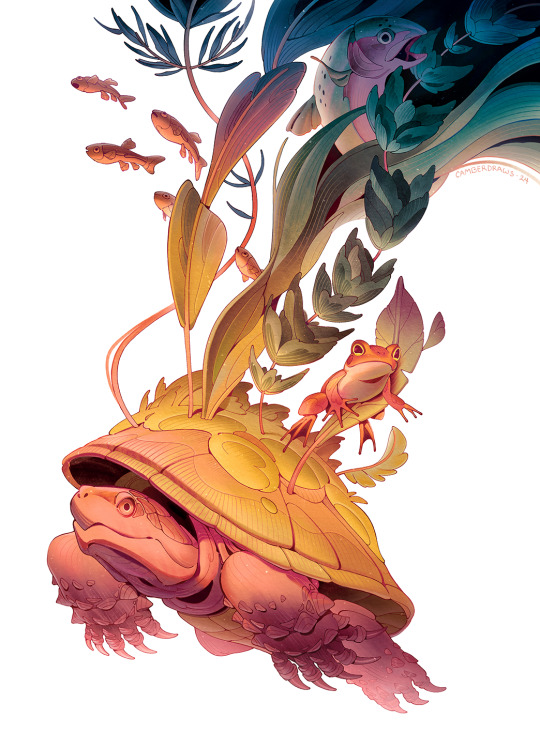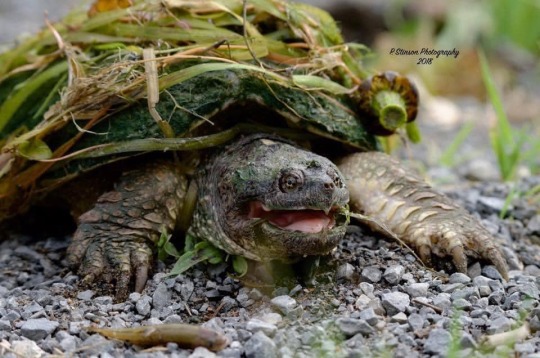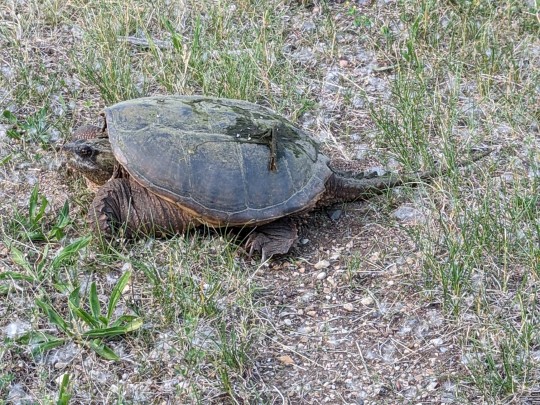#snapping turtle
Explore tagged Tumblr posts
Text



Mar 2025
#lake#water#turtle#naturephotography#snapping turtle#red eared slider#photography#naturelovers#nature#originalphotography#missedmilemarkers
51 notes
·
View notes
Text

This turtle has a bit more than algae growing on its shell
#illustrators on tumblr#artists on tumblr#art#my art#snapping turtle#frog#rainbow trout#minnow#plants#nature#original art#camberdraws#lets be real#this is just water type torterra
14K notes
·
View notes
Text
I was being chased by my crush who was riding a giant snapping turtl
2K notes
·
View notes
Text
I got a halarious review of my Aquarium today and I need people to see this shit so bad

Okay, we all read that? Good. You’re probably wondering why the fuck someone would question whether or not we have a turtle at the aquarium that’s real. It’s because he’s a 98 year old lazy Alligator Snapping Turtle. He can hold his breath for almost an hour. The old man is not active, and he shows us no interest in being active.
Behold! The “fake” “plastic” turtle in question!!!!
But seriously, if you are ever at a Zoo or an Aquarium and have questions about the animals or their welfare, you can always ask any of the staff and they are always happy to help educate you. Do not assume you know the whole story.
#alligator snapping turtle#snapping turtle#posts abt my job#aquarium#marine biology#turtle#turtles#zoology#biology#fish#sea creatures
2K notes
·
View notes
Text

Snapping turtle sketch
-2934
#art#traditional art#sketch#daily sketch#ballpointsketch#ballpointpen#turtle#snapping turtle#reptile#wildlife#wildlife sketch#reptile sketch#reptile art
929 notes
·
View notes
Text

Raph HATES hot weather. Be like Raph don't get sun strokes (it was actually a heat stroke...oops...im not a native speaker, what do you want) and be hydrated 🌞🥤
#my art#rottmnt#rise of the tmnt#rottmnt raph#rise raph#Raph#turtle tots#baby raph#snapping turtle#hot weather#summer#stay hydrated#gals!
1K notes
·
View notes
Text


Common Snapping Turtle (Chelydra serpentina), wearing her fancy plants, family Chelydridae, ONT, Canada
photograph by Phil Stinson
1K notes
·
View notes
Text

fellas, is it gay to light a cigarette for your homie when his hand is hurt?
#my art#fanart#tmnt#teenage mutant ninja turtles#tmnt fanart#raphael#bayverse turtles#snapping turtle#casey jones#tmnt rasey#rasey
535 notes
·
View notes
Text

Smile like the common snapping turtle (Chelydra serpentina)! This robust reptile, found throughout the eastern and central United States, as well as certain regions of southern Canada, can grow to exceed 70 lbs (31.8 kg) in weight. Its diet includes nearly anything it can catch: Birds, small mammals, fish, and aquatic vegetation are all on the menu. The common snapping turtle is also relatively long- lived, with some individuals surviving for 30 years in the wild—and even longer in captivity.
Photo: billielafond, CC BY 4.0, iNaturalist
#science#nature#natural history#animals#fact of the day#did you know#turtle#tortoise#herpetology#cool animals#snapping turtle#cute animals#smile
751 notes
·
View notes
Text

My next enamel pin Kickstarter: Reptile Mutations launches tomorrow!
What other reptiles would you like to see?
You can find the campaign page here:
#kickstarter#reptile art#reptiles#animal art#enamel pins#pins#art#crocodile#horned lizard#snapping turtle#rattlesnake
309 notes
·
View notes
Text

a little alligator snapping turtle
terf fuck off
made in 2023
#snapping turtle#alligator snapping turtle#turtle art#animal art#herpetology#printmaker#printmaking#traditional art#traditional printing#traditional printmaking#block print#block printing#small artist#linocut print#linocarving#linoprint#linocut#artists on tumblr#butch artist#lesbian artist#trans artist#original art#nature art#disabled artist#art#linogravure#small art account
210 notes
·
View notes
Text





Pulled off to the size of the road SO fast to get out and take pictures of this enormous handsome guy. Snapping turtles are so cool
2K notes
·
View notes
Text

stay resilient! / digital collage
a collage to celebrate urban flora & fauna 🌿
#my collage#collage#original collage#digital collage#nature#nature art#snapping turtle#bugblr#bug art#botanical art#wetlands#urban wildlife#wildlife#wildlife art#visual art#environmental art#animal art#artblr#artists of tumblr#original art
101 notes
·
View notes
Text


Common Snapping Turtle (Chelydra serpentina) basking beautifully in a local spillway
244 notes
·
View notes
Text

Half tortle, half amethyst dragon. Wonac is the acting captain of the carrack, Korvikoum
#art#artists on tumblr#digital art#digital illustration#drawing#artwork#character design#small artist#doodle#half dragon#tortle#dnd character#dnd art#pirates#sailor#snapping turtle#anthro#scalie#small art account#dnd oc#oc#oc art#my ocs#original character
48 notes
·
View notes
Text
Nightmare Critter OC

Quote: “Talking ain’t usually what happens when folks come looking for me.”
I deed eet. I made one. She is a snapping turtle.
#myart#putterpenart#oc#smiling critters#nightmare critters#poppy playtime chapter 3#poppy playtime chapter 4#turtle#snapping turtle#nightmare critter oc#smiling critter oc#smiling critters au#poppy playtime au
141 notes
·
View notes